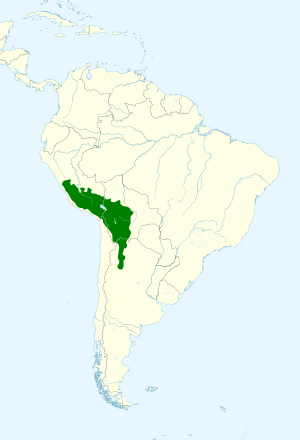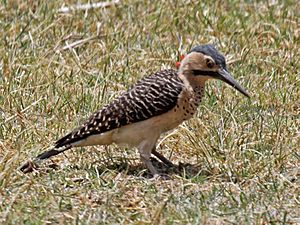Andean flicker facts for kids
Quick facts for kids Andean flicker |
|
|---|---|
 |
|
| Conservation status | |
| Scientific classification | |
| Genus: |
Colaptes
|
| Species: |
rupicola
|
 |
|
| Range of "southern" Andean flicker | |
The Andean flicker (Colaptes rupicola) is a type of bird that belongs to the woodpecker family. You can find these birds in South American countries like Argentina, Bolivia, Chile, Ecuador, and Peru.
Contents
About the Andean Flicker
Bird Families and Groups
Scientists group animals to understand them better. The Andean flicker is part of the Colaptes group of woodpeckers. It is closely related to the Chilean flicker.
There are three main types, or subspecies, of the Andean flicker:
- C. r. rupicola
- C. r. cinereicapillus
- C. r. puna
Sometimes, C. r. cinereicapillus is even considered a separate species. But in this article, we will talk about all three as subspecies of the Andean flicker.
What Does It Look Like?
The Andean flicker is about 32 cm (13 in) long. Males and females look quite similar, but there are a few differences on their heads.
Colors and Markings
- Head: Adult males have a dark gray head from their forehead to the back of their neck. Sometimes, there's a tiny hint of red on the back of the neck. Their face, chin, and throat are a pale, creamy white. They have a thin black stripe on their cheek, which has red tips on the feathers.
- Females: Females have an all-black cheek stripe and no red on the back of their neck.
- Body: Both sexes have brown, light brown, and creamy white stripes on their upper body. Their tail feathers are white with thin dark stripes. Their flight feathers are dark brown with narrow pale stripes.
- Tail: The top of their tail is black. The middle and outer tail feathers have thin, lighter stripes. The underside of their tail is dark brown, sometimes with a yellowish edge.
- Underparts: Their belly is whitish. Their chest often has an orange-buff color and small blackish spots. Sometimes, these spots are also on their sides.
- Other Features: They have a long black beak. Their eyes are bright lemon yellow. Their legs can be yellowish-gray, greenish, or grayish-pink.
Young Flickers
Young Andean flickers are not as brightly colored as adults. Their eyes might be pale blue or reddish-brown. They have creamy tips on the feathers at the back of their head. Their underparts have stripes instead of spots. Young males usually have some red on their nape (the back of their neck).
Differences in Subspecies
- C. r. puna: This subspecies looks like the main type but is darker both above and below. The spots on its chest are bigger. Its tail usually has fewer stripes. Its legs are a dull greenish color. The female's cheek stripe is often hard to see. Both males and females of this type have a dark red patch on the back of their neck.
- C. r. cinereicapillus: This one looks quite different! Its face, throat, and chest are a rich tan-buff color. Its belly and rump are yellow-buff. Its chest has black stripes instead of spots. It has no red on its nape. The red tips on its cheek feathers are only on the last few feathers, not all of them.
Where They Live and Their Home
Geographic Range
The different subspecies live in different areas:
- C. r. cinereicapillus: This is the northernmost type. It lives in southern Ecuador and central Peru.
- C. r. puna: This type is found in central and southern Peru.
- C. r. rupicola: This main type lives from northern Chile, through Bolivia, and into northwestern Argentina.
What Kind of Places Do They Like?
The Andean flicker loves open spaces. It lives in high-altitude grasslands called páramo and puna. It also lives in woodlands with Polylepis trees, rocky areas, and places with mixed grass and some taller plants. They often use rocks, cliffs, and trees as places to look out for food or danger.
They usually live at elevations between 2,000 and 5,000 m (6,600 and 16,400 ft). Most often, you'll find them above 3,000 m (9,800 ft). If they are seen at lower elevations, it's usually because they are looking for food when they are not breeding.
Andean Flicker Behavior
Do They Move Around?
Andean flickers usually stay in the same area all year. However, if there's a lot of snow or it gets very cold at the highest elevations, they might move to lower areas.
What Do They Eat?
The Andean flicker mostly finds its food on the ground. They often forage alone, in pairs, or in groups of up to 10 birds. Sometimes, even larger groups have been seen! They will fly down from a high spot, then dig and sweep away small stones and dirt to find their prey. After finding food, they often fly back to a high perch.
Their diet mainly consists of insects. They eat beetles (both adults and larvae) and other large larvae, like those of butterflies. They also eat other adult insects.
How Do They Raise Their Young?
The Andean flicker has a unique way of nesting for a woodpecker. They nest in groups, with many pairs (10 or more) nesting very close to each other. They dig out a nest hole in an earthen bank or in the soil on a rock face.
- Nesting Season: In central Peru, they are thought to nest from September to November. In other areas, it might be from January to March. Cold weather and snow during the wet season can affect when they start nesting.
- Parental Care: Both parent birds help feed the chicks.
- Unknown Details: We don't know how many eggs they lay, how long the eggs take to hatch, or how long it takes for the young birds to leave the nest.
What Sounds Do They Make?
The Andean flicker makes many different sounds.
- Common Calls: Their most common calls are a loud, sharp kweeir and a loud tew-tew-tew.
- Male Calls: Males make a kwa-kwa-kwa, wee-a, wee-a or kway-áp call when they are displaying.
- Contact/Alarm Calls: They also make single or grouped peek or kek sounds. These are probably used to stay in touch with each other or to warn of danger.
- Long-Distance Call: They have a clear, descending trill sound, like brrrridip, which is likely used for communicating over long distances.
Status and Protection
The IUCN (International Union for Conservation of Nature) looks at the "northern" and "southern" Andean flickers separately. Both types are considered to be of Least Concern. This means their populations are stable, and they are not currently at risk of disappearing.
They live in large areas, and their population sizes are believed to be steady. No immediate threats have been found for either type. The species is generally uncommon to fairly common in most places. In Ecuador, where it was first seen in the 1990s, it is uncommon and found only in certain spots. The Andean flicker lives in several national parks and protected areas.



